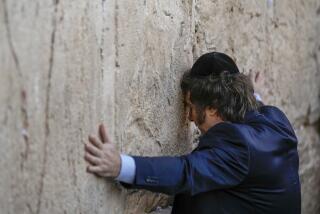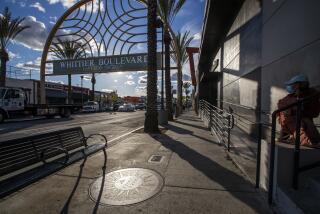Spain’s Little Piece of Africa
MELILLA, Spain ‚ÄĒ As evening descends along King Juan Carlos Avenue, shopkeepers shutter their stores and people stroll and chat amiably, some in Spanish, and just as many in Tamazight, a Berber dialect.
On a nearby two-block stretch, sparkly Christmas decorations have been strung across the street from Mohammed’s Gift Store, around the corner from the Hindu temple and a couple of doors from the 80-year-old synagogue. The Sacred Heart Roman Catholic Church tolls its bells for evening prayers.
And a few steps away, the Cervantes Cafe is halal, in accordance with Islamic dietary law.
For half a millennium, the Spanish have held on to this little piece of Africa, an enclave carved by conquistadors chasing the last Moors from Catholic Spain. Melilla and its sister enclave, Ceuta, are sovereign Spanish territory with Spanish citizens and flag, geographically in what is today Morocco: the last remnants of Europe in Africa.
The city’s leaders hold up Melilla, the more remote of the two enclaves, as a shining example of ethnic coexistence that can serve as a model for an increasingly divided world. The Melilla mantra, repeated faithfully by politicians and community leaders, goes like this: four religions living side by side in harmony sharing less than 5 square miles and 500 years of history.
Catholics, Muslims, Jews and Hindus do get along better here than in most places these days. But just below the surface, there is tension, latent mistrust and uncertainty over Melilla’s identity, economic well-being and future.
Melilla’s Christian majority is losing ground to a fast-growing, younger Muslim community that will one day surpass it. Jews have been leaving steadily for years. The Muslims, while making economic gains, still lag behind in their share of political power.
These changes feed a debate over the ‚ÄúSpanishness‚ÄĚ of the place and its people, and whether Melilla will survive as a successful experiment in multiculturalism, or descend into dangerous fragmentation.
‚ÄúMelilla is like a married couple that lives together, they have their suspicions about one another, but they keep quiet,‚ÄĚ local historian Vicente Moga Romero said. ‚ÄúThen the moment arrives when it all breaks apart.‚ÄĚ
This strategically significant geographic anomaly also serves as the gateway to Europe for tens of thousands of illegal immigrants from Africa and elsewhere.
Hugging the Mediterranean and hemmed in by Morocco, Melilla can be reached from mainland Spain only by airplane or an eight-hour boat ride. Looking at an official map of Spain, Melilla and Ceuta are like crumbs that fell off the table and are sitting on the floor.
Just about all the people who live in this relatively well-off city of 65,000 identify themselves first as Spaniards. Many of the Muslims, who were born in Morocco or have parents who were, also call themselves Berbers; some of the Christians refer to themselves as Spaniards ‚Äúof peninsular origin.‚ÄĚ
‚ÄúThis is a special city,‚ÄĚ said Jonaida Sel-lam, 28, a Melilla social worker born to a Tunisian mother and Moroccan father. A secular Muslim, she figures she can be Spanish and Berber the way people in Barcelona can be Spanish and Catalan. ‚ÄúGiven our unique and I would say privileged geography, the role we should play is that of the bridge between Morocco and Europe, between the First and Third Worlds.‚ÄĚ
The reality is quite different, she says. Life in Melilla as harmonious bliss is a myth, she says, the slogans about coexistence empty. Muslim residents of Melilla experience the highest unemployment rates, largest number of high school flunk-outs, lowest representation within the well-paid city government.
The mother tongue of most, Tamazight, is relegated to a second-class status, she complains -- not taught in schools and infrequently heard on state TV. Most people of Moroccan ancestry, even if their families lived in Melilla for generations, could not hold Spanish citizenship until the mid-1980s.
Though few will talk about it openly, some Catholics view their Muslim neighbors as a potential fifth column.
‚ÄúThere is an uncertainty, a doubt, a kind of fear,‚ÄĚ said Joaquin Gonzalez, 61, a retired banker and local head of Caritas, the Catholic charity whose clientele in Melilla these days is nearly all Muslim.
‚ÄúMelillianos wonder, if someone retains ties to Morocco, then, at the moment of truth, will they be a true Spaniard, or will they be Moroccan?‚ÄĚ
Morocco periodically asserts a claim to Melilla. Sel-lam and others think politicians here use the threat of an attempted takeover by Morocco as a red herring to stoke anxiety in a Catholic population fearful of a threat to its Spanish identity -- and to keep the Berbers in their place.
Juan Jose Imbroda is the president of Melilla, a position actually closer to that of mayor or governor. Under Spanish law, Melilla and Ceuta have the unique political status of ‚Äúautonomous city,‚ÄĚ which means they are a notch above a city but below an autonomous region such as Andalusia or Catalonia.
A member of the rightist Popular Party, Imbroda, 61, is part of Melilla’s traditional elite. His office in City Hall, all dark wood, upholstered furniture and chandeliers, is down a marble passageway from the oil painting of Pedro de Estopinan, the conquistador who claimed this patch of land for Spain in 1497. He said he was confident that Melilla would always remain Spanish, that Muslims would assimilate and that Christians, while slowly declining in numbers, had nothing to fear.
‚ÄúGeography does not always define borders,‚ÄĚ Imbroda said. Melilla will never be ceded to Morocco ‚Äúbecause no one wants to go backward. And it would be a step backward in which we would all lose in all areas. Everyone would lose economically, in healthcare, in education.‚ÄĚ
Imbroda says Melilla’s population is still two-thirds Christian; most other sources, including the national government, put the Muslim population much closer to 40% or 50%.
Imbroda led the battle to unseat the only Muslim who ever led the city government, Mustafa Aberchan, who was elected president in 1999. He was ousted about a year later, in a bitter fight that ended when city legislators from the left and right united to censure him. Although many issues were in play, Aberchan today blames ‚Äúinstitutional racism,‚ÄĚ what he acerbically calls Fear of the Moor.
‚ÄúI remember Imbroda saying Melilla was not ‚Äėready‚Äô for a Muslim president,‚ÄĚ he said over coffee. ‚ÄúThey made our lives miserable while we were in office, without ever saying the real reason: They did not want the Moor to govern.‚ÄĚ
Aberchan, a physician, heads the Coalition for Melilla, a political party that has eagerly bounced back. The coalition more than doubled its take in recent elections and holds seven seats in the 25-member local parliament.
People from Imbroda’s faction dismiss the coalition as an ethnic-based party that promotes religious sectarianism; leaders of the coalition say it represents a broad, more diverse spectrum of Melilla’s chronically disenfranchised. Most of its members are in their 30s. Of its seven lawmakers, six are Muslim. (Imbroda’s Popular Party, with 15 seats, has two Muslims.) Three of the coalition’s seats are held by women: one Christian, one Muslim who wears a head covering and one Muslim who does not.
‚ÄúI‚Äôm one of those people who think we can change the world,‚ÄĚ said Salima Abdeslam, 27, one of the coalition‚Äôs parliamentary representatives. During a brief meeting at the party‚Äôs office in City Hall, Abdeslam wore a long coat and a cream-colored scarf pulled tightly around her face.
The governorship of Melilla was long controlled by fervently conservative, nationalistic elements. A statue of Gen. Francisco Franco is displayed prominently, bedecked the other day with flowers and red-and-gold bandannas to represent the national flag. Melilla was one of Franco’s staging grounds for his rebellion against the Spanish Republic, which triggered Spain’s devastating 1936-39 civil war. For most of its existence, Melilla was run by the military.
Part of Melilla’s identity crisis today comes from its symbiotic relationship with Morocco. Tijuana-like, the border is a frenetic transit point of merchandise, laborers, drugs and contraband. Close it even for a day, and both sides feel it. Melilla depends on Morocco, and vice versa. All of Melilla’s fruit, vegetables and fish come from Morocco (importing from mainland Spain is more costly), and 30,000 Moroccans cross into Melilla every day to sell their produce or to buy electronics, clothing and manufactured goods. An additional 6,000 or so Moroccans cross daily to work in Melilla.
Some studies have put the economic disparity between Spanish Melilla and the nearest Moroccan town as one of the greatest in the world. The contrast is stark. Melilla’s neat sidewalks, Modernist architecture and orderly shopping blocks give way as you enter Morocco to vacant fields, beggars, stray dogs, wandering goatherds and, on a recent morning, a Moroccan policeman beating youths with a whip.
The heavy metal fences topped with sharp barbed wire that separate Melilla from Morocco are being reinforced these days, lengthened and made taller. This is mostly to stop the desperate waves of sub-Saharan Africans that erupted in deadly violence a couple of months ago. Several local commentators speculated at the time that the immigrants were being pushed by Morocco to put pressure on Spain to relinquish its enclaves.
Implausible, perhaps, but the theory fed on the fears here about the future.
The ranks of nonmilitary youth are shrinking, leaving Melilla without a new generation of workers. The canneries that once sustained Melilla’s economic base have long closed, the fishing fleets forced to move as disputes over water rights went unresolved.
Salomon Benzaquen Cohen, 48, a businessman and head of a centuries-old Jewish community, echoed Muslim and Catholic leaders who said the city was going to have to find new life through the development of jobs and business.
Benzaquen, whose family has lived in Melilla for many generations, has seen his own children leave for the mainland. Before World War II, Melilla’s 8,000 Jews represented 20% of the city’s population; today, just 1,200 Jews account for barely 2% of the population.
‚ÄúI‚Äôd like for the young to return, but it is not so easy,‚ÄĚ he said. ‚ÄúThey leave to study, and then the opportunity to work is not here. The city has got to provide opportunities, and if not, the youth will continue to go looking elsewhere.‚ÄĚ
Others say all is not lost, that Melilla faces a golden opportunity and can avoid the race riots of France, for example, and instead become, as Aberchan put it, the ‚Äúdesired Jerusalem.‚ÄĚ But it will take broader economic prosperity and political empowerment, they say.
Moga Romero, the local historian, said Melilla was at a crossroads. As much as he loves the city where he, his parents and his grandparents were born, he wonders if it’s worth sticking it out.
‚ÄúEvery day we ask ourselves if we should continue living here,‚ÄĚ he said. ‚ÄúIt‚Äôs a debate, like living on the skirt of a volcano.‚ÄĚ
More to Read
Sign up for Essential California
The most important California stories and recommendations in your inbox every morning.
You may occasionally receive promotional content from the Los Angeles Times.











